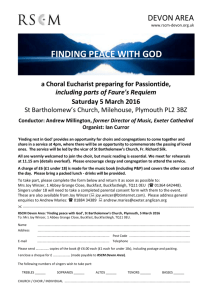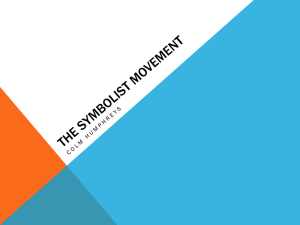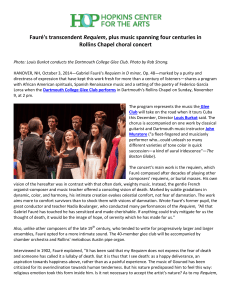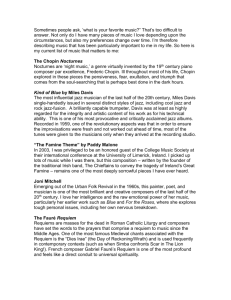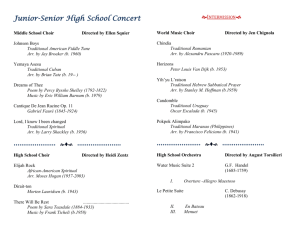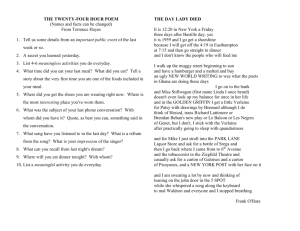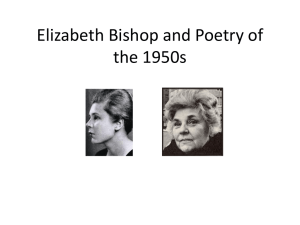É
advertisement
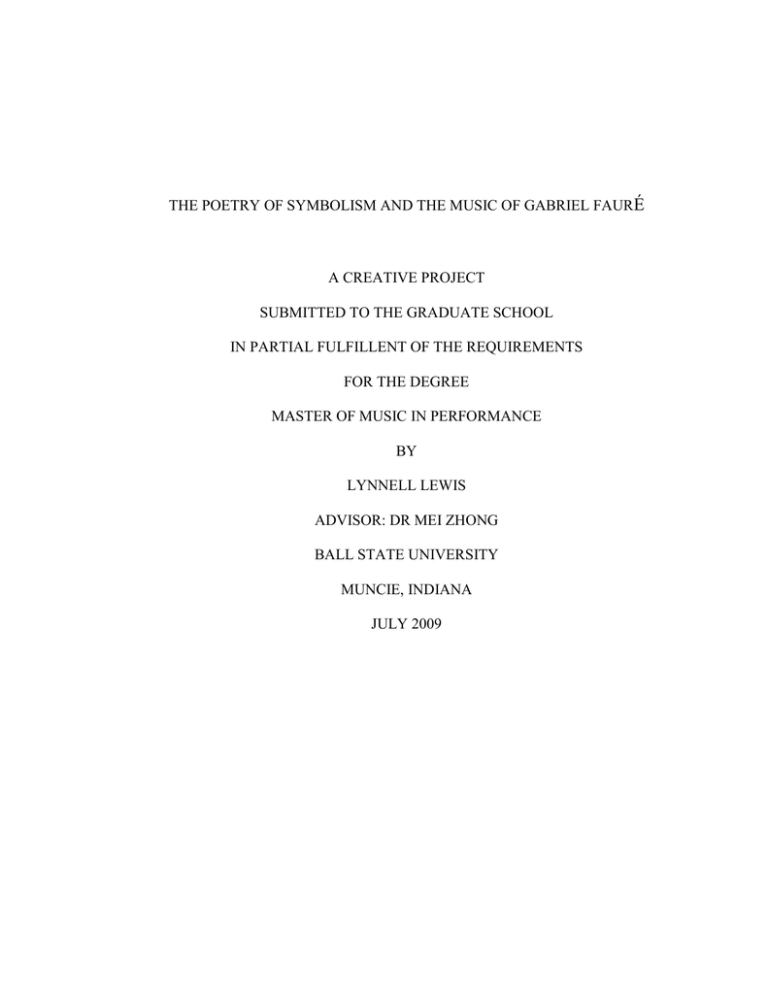
THE POETRY OF SYMBOLISM AND THE MUSIC OF GABRIEL FAURÉ A CREATIVE PROJECT SUBMITTED TO THE GRADUATE SCHOOL IN PARTIAL FULFILLENT OF THE REQUIREMENTS FOR THE DEGREE MASTER OF MUSIC IN PERFORMANCE BY LYNNELL LEWIS ADVISOR: DR MEI ZHONG BALL STATE UNIVERSITY MUNCIE, INDIANA JULY 2009 TABLE OF CONTENTS 1. Introduction ................................................................................... 1 2. Gabriel Fauré .................................................................................. 3 3. Fauré‟s Work and the Influences of Late 19th Century France .... 7 4. Paul Verlaine ................................................................................. 9 5. Fauré, Verlaine and Symbolism ..................................................... 14 6. Description of Songs and Performance issues ............................... 17 . Mandolin .............................................................................. 17 . En Sourdine .......................................................................... 18 . Green .................................................................................... 19 . A Clymène ........................................................................... 21 . C‟est l‟exstase ...................................................................... 23 7. Conclusion ...................................................................................... 25 Appendix of Poetry.............................................................................. 27 Mandoline ....................................................................................... 27 En Sourdine .................................................................................... 27 Green .............................................................................................. 27 A Clymène ...................................................................................... 28 C‟est l‟exstase................................................................................. 28 Bibliography ............................................................................................. 29 Recital Program ........................................................................................ 31 Introduction The symbolist poets whose work emerged in1880‟s France sought to loosen the ties of naturalism and realism by relying on dream-like images and the subjective experiences of the emotions, rather than the objective reality of the outer world. They “courageously invaded an unexplored world of human emotion and feeling, deeper than mere sensation, more difficult to seize than logical reasoning.” 1 Gabriel Fauré, like many other composers of his time, was drawn to the verse of symbolist poet Paul Verlaine and used it in two of his important song cycles, Cinq mélodies “de Venise” and La bonne chanson, as well as in other songs. This paper will explore Cinq mélodies “de Venise,” which is much beloved by singers but which also poses some significant performance challenges, especially in the interpretation and expressivity of Verlaine‟s poetry. Gabriel Fauré used a unique harmonic language to communicate the poetry of his songs. Much of Verlaine‟s poetry was inspired by the events of his life, infused with his own journey towards individual freedom and expression. The union of these two artists in Cinq mélodies “de Venise,” composed in 1891, is a song cycle composed at the beginning of what is considered to be Fauré‟s mature period, using poetry from two of Verlaine‟s works, Fetes gallante and Romances sans paroles. By selecting poems which 1 Kenneth Cornell, The Symbolist Movement (New Haven: Yale University Press, 1951), vi. 2 were linked thematically, Fauré sought to unify the musical and literary content of a set of songs for the first time. Beginning with biographies of the composer and the poet, I will then discuss some of Fauré‟s unique gifts as a composer and Verlaine‟s contributions to late nineteenthcentury poetry, with the language of Symbolism as a common denominator. Next I will describe each of the five songs of the cycle in turn, and finally, I will pose some possible solutions to the performance issues that the dreamlike imagery of the text poses for the singer. Gabriel Fauré (1845-1924 ) Gabriel Fauré was born in Pamiers, France in 1845. At the age of nine, he began his musical studies at the Ecole Niedermeyer in order to acquire the skills to become a church musician. During his adolescence at the Ecole, Camille Saint-Saëns took over the senior piano class. Saint-Saëns was more than a teacher to Fauré, “he became a friend and guide.”2 In his class the young Fauré was introduced to the modern music of Schumann, Liszt, and Wagner, and “under Saint-Saëns‟ friendly and conscientious eye Fauré began to compose.”3 Among his youthful compositions were six of his first songs, two of which were never published. In 1865 he won first prize for composition. The young Fauré also won two prizes for literature,4 showing an early sensitivity to words that may have influenced his work as a composer of the mélodie. In addition to the tutelage of Saint-Saëns, the other far-reaching effect of Fauré‟s studies at Ecole Niedermeyer was the influence of Niedermeyer himself, who was “ a pioneer in the rediscovery of polyphonic music in France.” 5 When Fauré left Ecole Niedermeyer in 1865, he was twenty and had spent eleven formative years in training. 2 Jean-Michel Nectoux, Gabriel Fauré: A Musical Life. Trans. Roger Nichols (Cambridge: Cambridge University Press, 1991), 9. 3 Ibid. 4 Jean-Michel Nectoux, Gabriel Fauré: His Life through his Letters (New York: Marion Boyars Publishers, 1984), 15. 5 Nectoux, Gabriel Fauré: A Musical Life, 6. 4 His “… long immersion in ancient polyphonic music and in modal usage was to have a profound and increasing influence on his composing language.” 6 In his young professional life Fauré worked as organist and choirmaster for long periods of time, first in the provinces, which he found monotonous, and later in Paris. When he finally returned to Paris for good, he attained a stable position as maître de chapelle at the church of Ste-Madeline with the help of Saint-Saëns, “the guardian angel watching over Fauré‟s career.”7 Unfortunately his salary was not enough to sustain him and it was necessary to supplement it by teaching private lessons, traveling around Paris in order to do so. During this time, he was encouraged by his friends, Louis and Pauline Viardot, to write an opera which could bring him to the attention of a larger audience and create a livable income. This would be something he would pursue intermittently for the following twenty years.8 He was one of the founding members of the Société nationale de musique, which included Cesar Franck, Edouard Lalo, Vincent d‟Indy, Henri Duparc, Jules Massenet, Camille Saint-Saëns, Claude Debussy and other musicians. During this time Fauré‟s songs were often heard at the concerts of the Société. The salons of Paris were the other primary venue for Fauré‟s work. It was here that he first found an audience who truly appreciated his music; many of his songs were first sung in the salons. Unfortunately, his musical reputation suffered as a result of his reliance upon the patronage of the salons: This fact has been held against him and has even led some people to consider his whole output as being „salon music.‟ In 1922, a journalist made the loaded remark 6 Ibid., 12. Ibid., 20. 8 Ibid., 28. 7 5 „You‟ve had a lot of success in the salons‟, to which Fauré replied, „I was very much involved in making a living. I had some good friends, and when you‟re an unknown to the musical public at large it‟s nice to find people who understand you.9 The years of Fauré‟s musical youth were thus spent in the inspiring artistic milieu of Paris among artists and the aristocratic supporters of music, nevertheless making a living was to be a constant preoccupation for him during these years and indeed, throughout his forties. Since he was without personal wealth, he had no choice but to survive on his small church salary and private teaching. A turning point in his life came with his appointment to the Paris Conservatoire as a professor of composition, at the age of 51. In 1905, at the age of 60, he became the director. As a teacher of composition he was much beloved by his students, two of whom included Maurice Ravel and Nadia Boulanger. With his appointment as director of the conservatoire, he immediately instituted numerous reforms. When his working year was over, in the last days of July, Fauré would leave Paris and spend the two months until early October composing in idyllic settings, most often near a lake, where the peace and serenity gave him the “calm, space and the anonymity he needed for his work.”10 One of the additional benefits of Fauré‟s directorship of the conservatoire is that his work finally gained the fame and attention it had long deserved. One of the tragedies of Fauré‟s life was the deafness that began to overtake him as early as 1901. By 1910, “ he complains of hearing the middle register faint but in tune, „while the bass and treble are an incoherent jumble!‟”11 Even so, in his later life, he was finally able to enjoy the fruits of success. He traveled widely and continued to 9 Excelsior, 12 June 1922, quoted in Nectoux, Gabriel Fauré: A Musical Life, 35. Ibid., 270. 11 Fauré to Marie Gabriel Fauré, July 1910, Lettres intimes, ed. Phillipe Fauré Fremiet (Paris: La Colombe, 1951), 79, quoted in Nectoux, Gabriel Fauré: A Musical Life, 292. 10 6 compose despite the pain and mental anguish the loss of hearing must have caused for him. He died peacefully surrounded by his family on November 4, 1924 Fauré’s Work and the Influence of Twentieth Century France When studying about Fauré and his music, some common threads become clear. Some are musical in nature and others are about the man himself; both are critical in understanding the music. In his book, Fauré and French Musical Aesthetics, Carlos Caballero devotes an entire chapter to “The question of sincerity” in which he quotes an essay Paul Dukas wrote shortly after Fauré‟s death: Those who had the joy of sharing Fauré‟s intimacy know how faithfully his art reflected his being – to the extent that his music at times would seem to them the harmonious transfiguration of his own exquisite charm. Others did their utmost to rise above themselves or, if they collaborated with a poet, to surpass that collaborator. Fauré, with a unique grace, without constraint, gathers every external impression back into his inner harmony. Poems, landscapes, sensations that arise from the spur of the moment or the fleeting wave of memories – whatever sources his music springs from, it translates above all his own self according to the varied moods of the most admirable sensibility.12 Caballero goes on to question how one might „reflect his own being‟ when one is in collaboration with a poet. He answers by quoting one of Fauré‟s students Charles Koechlin: What is peculiarly Fauré‟s is an absolute penetration of things and beings; we would not say that his music adapts itself to its subject, but rather that it constitutes the essence of it; a magic mirror, his music becomes the subject itself. A unique gift, to 12 Paul Dukas, “Adieu à Gabriel Fauré,” La revue musicale 6 (1 December, 1924): 8, quoted in Carlos Caballero, Fauré and French Musical Aesthetics (Cambridge: Cambridge University Press, 2001), 13. 8 make the poets‟ thought live again; an inexplicable mystery, never to lose, for all that, his exceedingly recognizable personality.13 Fauré then, for many who were “initiated” into his music early on, was first and foremost, a composer whose voice was uniquely his own. There is an ineffable quality to his music that cannot quite be defined even when one understands his harmonic and rhythmic language. At a time when many composers were unable to escape the behemoth of Wagner‟s overwhelming achievements, Fauré, while acknowledging Wagner‟s genius, quietly went his own way.14 Pulling at the threads of tonality without completely unraveling the cloth, Fauré‟s harmonic language, infused with the church modes of his youthful training, undermined the tonic-dominant relationship which had dominated music for two hundred years.15 The extent to which his music was influenced by the artistic ferment in Paris of the late nineteenth century is difficult to gauge. Certainly artistic revolution was in the air in literature, the visual arts and music. While Fauré did not set out to break the rules of tonality as an end in itself, his music found acceptance in the milieu of Paris, at least partially because there were innovatory trends and rules being broken throughout the artistic world.16 13 Charles Koechlin, “Les tendances de la musique moderne française” (1921), in Encyclopédie de la musique et Dictionnaire du Conservatorie, ed. Albert Lavignac and Lionel de La Laurencie, 2 nd prt (Paris: Delagrave, 1925) 1:126, quoted in Caballero, 14. 14 Jim Samson, Music in Transition: A Study of Tonal Expansion and Atonality, 1900-1920 ( New York: Oxford University Press, 1993), 63. 15 Ibid. 16 Ibid. Paul Verlaine 1844 – 1896 Paul Verlaine and Arthur Rimbaud were at the forefront of a literary movement that was to have lasting artistic influence far beyond their short, tumultuous lives. The intense, dramatic lives of Verlaine and Rimbaud became the material of legend as evidenced by the recent film, Total Eclipse. While their drama underscores the archetype of the tortured, penniless artist, nevertheless, embedded within their sad, addicted lives there existed a flame of truth and beauty that not only was recognized and celebrated in its own time, but which has lived on to inspire poets and musicians ever since. Born in Metz, France in 1844, Verlaine showed an early interest in poetry that was thwarted by his bourgeois family. This did not stop him, however, from sending a poem to Victor Hugo when he was only fourteen. He finished his high school education in Paris and began his working life as a civil servant at City Hall, following the wishes of his father. During this time he began to frequent the cafés and bars at night, meeting the poets who were to become his artistic community in years to come and beginning an addictive habit to absinthe, an hallucinogic form of alcohol. By the age of twenty-one he had published some poems and reviews in the journal L‟Art. His first collection of poetry to be published was Poèmes saturniens in 1866. “ …only the poet Stephane Mallarmé detected its originality. In this book, the lines are still even in 10 length, but their rhythms are irregular and „the deliberate imprecision‟ of Verlaine‟s voice is already present.”17 Fêtes galantes, his next collection, came only three years later in 1869. Regrettably, Verlaine‟s work was ahead of its time; the world of 1860‟s Paris wasn‟t yet ready for his originality. Another reason for the tepid reception of this volume was the public indifference toward poetry at that time:18 The music, the delicate shadings of the inner self, the courageous departure from traditional form and expression were to abide their time…Verlaine, before embarking on the adventure which was to separate him from French letters for many years, had sufficiently voiced…much of the fragile and suggestive melody that would make him one day celebrated, but perhaps that very fragility caused the volumes to go unnoticed in a world more accustomed to the sonorities of Victor Hugo or Leconte de Lisle.19 During this same period unfortunately, his dependency on drink and his tendency to violence were becoming more pronounced. In 1870, in a sincere effort to reform himself, he married seventeen-year-old Mathilde Mauté and wrote La bonne chanson as a celebration of their life together. Sadly their young marriage was soon disrupted by the Franco-Prussian war and the entrance of Arthur Rimbaud into their lives. Ironically, the young Rimbaud, impressed by Verlaine‟s poetry had sent his idol a poem in 1871, much as Verlaine had sent Victor Hugo a poem years before. In this case however, Verlaine invited Rimbaud to Paris where he joined the Verlaine household. Rimbaud‟s undisciplined nature fascinated Verlaine and completely disrupted the family. 17 Ruth L. White, Verlaine et les musicians (Paris: Librairie Minard, 1992), 63, quoted in Sara G. Hopkins, “Verlaine in Song: How Six Composers of Mélodie Responded to his Verse” (DMA diss., University of Maryland at College Park, 1996 ), 5. 18 Cornell, 6. 19 Ibid., 9-10. 11 Rimbaud received a mixed reception among Verlaine‟s friends and the world of French literature; on the one hand some recognized his budding genius, but on the other, they were repulsed by his rebellious spirit and dissolute ways. Verlaine, at Rimbaud‟s urging, finally left Paris with his young friend in 1872 and they traveled together through England and Belgium for the next two years, “ but the scandal of the Verlaine-Rimbaud relationship soon silenced comments on their work and virtually exiled them from French literature for a decade.”20 In July of 1873, Verlaine was jailed for shooting Rimbaud through the wrist in a drunken quarrel, and served eighteen months in prison. In 1874, during his incarceration, he studied Shakespeare and Don Quixote and wrote Romances sans paroles, considered to be his masterpiece. Sent through a friend to the magazine, Renaissance, Verlaine was awarded some hesitant praise however, “… the poems, which…reveal a poetic manner in which suggestion and music dominated thought, were denied much publicity.” This was indicative of the degree of hostility still felt towards Verlaine. When the entire volume of poems was released in March 1874, it was met with complete indifference. It wasn‟t until 1884 that the poems were finally published successfully. Verlaine saw Rimbaud once more in 1875 upon his release and never saw him again. The forced disruption of his addictive habits during his time in jail had availed him the necessary breathing room to begin again; he renewed his faith in Catholicism, moved to England and made a living teaching French. He returned to France in 1877 and in the ensuing years taught college and tried unsuccessfully to farm. During his time teaching he published Sagesse, a series of poems 20 Ibid., 16. 12 that reflected his religious renewal. In 1883 a young man he had adopted in England and who had helped with his farming ventures, Lucien Letinois, died of typhus. Three years later, in 1886, his mother died. It was in these years that Verlaine‟s poems found publishers and an audience. He was simultaneously celebrated as France‟s leading poet and yet, he again descended into addiction. In his last years he continued to write, living in poverty. His health deteriorated and he spent long periods of time in public hospitals. It was during this time in the hospitals that a project between Verlaine and Fauré was proposed by the Princesse Edmond de Polignac. As an opening for her new atelier there was to be an opera, composed by Fauré with a libretto by Verlaine. Fauré, who admired Verlaine‟s poetry, initiated contact with the poet. While their collaboration was challenging because Verlaine left Paris for a long period of time with no explanation of his whereabouts, upon his return a year later, a series of meetings in cafés was at last arranged. These meetings proved to be thoroughly frustrating for Fauré because Verlaine never produced the work. In a letter to the Princesse de Polignac he wrote: “I won‟t conceal from you that this man, with all his extraordinary gifts, seems to me to have become incapable of the kind of effort, the kind of sustained application that a work of any importance would require…” 21 Needless to say, the opera never came to fruition, however the connection between the poet and the composer planted the seeds that were to become Cinq Melodies “de Venise.”22 21 Fauré to Princesse Edmond de Polignac, undated [late April 1891], Fondation Singer-Polignac, reprinted in Fauré, Correspondance, 169-171, quoted in Sylvia Kahn, Music’s Modern Muse: A Life of Winnaretta Singer, Princesse de Polignac (Rochester: University of Rochester Press, 2003), 52. 22 Kahn, 52. 13 In 1894 Verlaine was elected France‟s Prince of Poets and died in Paris two years later at the age of 52. Thousands of Parisians attended his funeral. Fauré played the organ.23 23 Nectoux, Gabriel Fauré: A Musical Life, 172. Fauré, Verlaine and Symbolism While there is little evidence that historians think of or define Fauré as a symbolist composer, in order for the singer to better understand the aesthetic of his music it could be helpful to understand how his music and philosophical outlook reflect the principles of symbolism. For singers, the challenges that arise from performing symbolist poetry are the same qualities that provide the essence of its beauty. In their search for a means of expressing “ineffable states of purity”24 symbolists found it necessary to conceive of poetry in a less representational style which led them to consciously obscure its meaning resulting in “a certain initial indifference to the goal of understanding.” 25 Breaking then, with the orderly, pictorial, representational style of the Parnassians, they opted not for raw sense data but for the “sensation of the sensation, or a purified form of sensory experience…we see how poetry drawing on such material can be compared with experience conveyed through the quintessential form of music. The vaguely medieval setting of many symbolist poems results from an attempt to achieve both sensory and metaphysical immediacy without describing anything remotely real.”26 24 John Porter Houston and Mona Tobin Houston, An Anthology of French Symbolist Poetry (Bloomington: Indiana University Press, 1980), 10. 25 Ibid. 26 Ibid., 12. 15 The idea of poetry as music, as shadow and light, as evocative, as suggestion, derived from the world of ideas, philosophy, and arguably, from the poets‟ own drive to create something original from the depth of their own being. Verlaine in Art poétique passionately describes his vision: Music before everything, and for that reason, prefer lines of an uneven number of syllables, vaguer and dissolving better into air, with nothing in them that is weighty or comes to a stop. You must also choose your words with a certain negligence: nothing dearer than the grey song where the indeterminate and the exact are joined. It‟s like beautiful eyes behind a veil, the great quivering light of noon; it‟s like, in a warmish autumn sky, the blue heap of bright stars! For we still want shades, not plain color, nothing but shades! Oh, but a subtle shade alone weds dream to dream and the flute to the horn.27 Verlaine further exhorts his fellow poets to “take rhetoric and wring its neck!”28 thus espousing the rejection of the old rules. In addition to the imagery of the words, the forms themselves, the rhymed alexandrine couplets with their balanced patterns were to be abandoned: “while you‟re at it, chasten rhyme somewhat; if you don‟t watch it, it may do God knows what! Oh who can tell of the misdeeds of rhyme?29” The result was poems that were written “in lines of nine, eleven and thirteen syllables, which are difficult for the ear to seize on and classify.”30 How then, one might ask, did Fauré‟s music reflect these symbolist ideals? In Music in Transition: A Study of Tonal Expansion and Atonality, 1900-1920 by Jim Samson, Mr. Sampson connects the symbolist poets‟ role in helping to “free the language of poetry from the shackles of precise meanings”31 with the mature music of Fauré. In addition to his discussion of Fauré‟s revival of modality and consequent undermining of 27 Ibid., 50. Ibid. 29 Ibid. 30 Ibid., 14. 31 Samson, 63. 28 16 the “tonic-dominant polarity of classical tonality,”32 as discussed briefly above, he adds that Fauré also imperceptibly changed enharmonic progressions, which served to loosen the syntactical connections between chords. Already in his songs of the eighties and nineties – above all in his settings of Verlaine – Fauré was developing an unobtrusively original harmonic idiom whose unmistakable flavour is at least partly due to a preference for “false relations,” added sixth harmonies and freely interchanging major and minor sevenths and ninths. The boldness of that idiom is subtly concealed by a fluid non-accentual rhythmic language and an evenly flowing accompaniment configuration.33 Thus, the flowing lines and uneven meters of Verlaine‟s poetry combined with Fauré‟s own commitment to line and fluidity by the means quoted above, to create melodiés that at times seem to float adrift like a summer afternoon. The words are purposely obscure and Fauré‟s harmonic and rhythmic language flawlessly enhance the images and settings created by the poet: “There are sometimes privileged moments when poetry and music are seen to join as brothers one with the other, as if through some sudden conspiracy, wrote Vladamir Jankelevitch. Rien de plus cher que la chanson grise Où l’Indécis au Précis se joint (Nothing is dearer than the grey song/ Where Indefinite and Definite meet). This „grey song‟ that Paul Verlaine celebrates in his Art Poétique belongs also to Fauré and it would be hard to understand his genius outside the context of symbolist poetry. His music has made its own the poet‟s „take eloquence and wring its neck.‟”34 32 Ibid. Ibid. 34 Vladimir Jankelevitch, Faure et l’inexprimable (Paris: Plon, 1974). As quoted in liner notes to “Faure:Preludes and Impromptus, Op. 103.” Pierre-Alain Volodat, piano. Naxos Classics. Written by Alain Cochard, translated by Keith Anderson. 33 Description of Songs and Performance Issues Mandoline The opening song, “Mandoline,” is the most immediately accessible and charming of the five with its lovely melody and quick tempo. While not strictly strophic, there are repeated motives in the first two verses of the song. The piano accompaniment, reminiscent of a mandolin or lute, consists of light arpeggiated eighth-note figures, and continues unbroken through the first two verses. The third verse uses new melodic material; a downward cascade of notes leads to a swirling effect between the voice and piano as the poet and composer describe the elegant joy of the dancers under the pink and grey moon. One of the issues in interpreting the text of this song is that the singer is acting as a narrator rather than as a player in the scene, implying a degree of emotional separation from the text. The poem, inspired by a series of paintings by Watteau depicting “18th century nobility in their „fêtes champètres, those elegant picnics redolent of a mixture of gaiety, sensuousness, melancholy, world-weariness and wealth,”35 and specifically by “The Mandolin Player” by Watteau36, give the singer a rare opportunity to see a picture of the poetry. The paintings were derived from the characters of the Commedia del Arte 3535 Robert Gartside, Interpreting the Songs of Gabriel Fauré, (Geneseo, NY: Leyerle Publications, 1996), 26. 36 Gartside, 28. 18 of 16th and 17th Century Italy and from French theatre and literature, so the poem was “discussing” characters who were well-known to the French of the late 18th Century. C‟est Tircis et c‟est Aminte, Et c‟est l‟éternel Clitandre, Et c‟est Damis qui pour mainte Cruelle fait maint vers tendre It is Tircis and it is Aminte, And it is the eternal Clitandre, And it is Damis who for many a cruel woman writes many a tender poem. Robert Gartside, in Interpreting the Songs of Gabriel Fauré points out that Fauré wrote a “very obvious tritone between the F natural in the bass and the B natural above it. All of this is to show that Clitandre is the „eternal bore‟ at the party, an idea the singer can easily indicate with his voice.” 37 Gartside also suggests that the “world-weariness and melancholy” gives this seemingly light-hearted song an edge of darkness which the singer may use to bring some depth into an interpretation.38 En Sourdine A striking contrast to the light atmosphere of a social gathering, “En Sourdine” describes in hushed tones the deep connection between lovers. Beginning with long, sustained notes in the vocal line above arpeggiated chords in the piano, Fauré describes the stolen afternoon of lovers with his masterful use of shifting harmonies and the quiet low register of the voice. Short counter-melodies arise out of the piano, interacting with the voice in a seamless comment that describes the languorous afternoon and the coming of evening. 37 38 Ibid., 29. Ibid. 19 While Mandoline sets the scene for the rest of the song cycle, with “En Sourdine” translated as “Muted,” the singer enters the more personal sphere of the love song. There is a deep peacefulness and tenderness in the poetry and in the structure of the melodic line. The text is subtle; in true Verlaine fashion, it offers hints rather than pointing directly at the story within. In order to fully embody the song one needs a vivid imagination to fill in the blanks. The last line of the poem: “Voix de notre désespoir, le rossignol chantera (Voice of our despair, the nightingale will sing),” begs the questions, why is the nightingale‟s song so sweet, and why does it signal the voice of despair? Penetrating these lines, each singer for herself, can explore the core of the Verlaine‟s and Fauré‟s intentions. Green With a quiet cheerful tenderness, “Green” continues the narrative of the lovers in a setting quite different from the calm of “En Sourdine.” Over urgent, pedaled eighth note block chords on the piano, the melodic line elegantly covers the entire range of the song in the first verse, setting the scene for the rest of the story in miniature, which describes the arrival of the lover with the “wind of morning.” With constant shifting of tonal centers, Fauré musically describes the excitement of the meeting, culminating on a high Fb, which at the end of the phrase descends down the octave. Example 1 20 As the excitement calms, the memories are recalled in one more burst of passion as the melody begins forte on a high E and descends stepwise to C# with a quiet half note. Example 2 21 The following phrase “Et que je dorme un peu, Puisque vous repossez (And may I sleep a little, Since you are resting),” concludes the song in a aura of calm and sweetness. “Green” is one of the few songs for which we have Fauré‟s written instructions about interpretation. There is some speculation that the Princesse Edmond de Polignac, to whom the songs are dedicated, was also strongly in Fauré‟s mind when he wrote these love songs,39 which, true or not, is a helpful image for the singer. In a letter to her in which he included “Green,” he said, “ Have I succeeded in transposing this wonderful canticle of adoration? I don‟t know. „Don‟t destroy it with your two white hands‟ 40 and if you don‟t like it at first sight, will you promise me not to lose heart, but read it through again? It‟s difficult to interpret: slow moving but agitated in feeling, happy and miserable, eager and discouraged! What a lot in thirty bars!” 41 In a letter to another friend, Marguerite Baugnies, who had sung “En Sourdine,” he gives the following advice for “Green:” “In “Green” I can‟t insist too strongly that it mustn‟t be sung slowly: it has to be lively, passionate, almost out of breath! And above all, sing it as if to yourself. I‟ve no desire to intrude my personal accents into other people‟s reveries.” 42 A Clymène “A Clymène” appears deceptively simple, however the mysterious nature of the poetry, reflected in the music, make it the most challenging song of the cycle. The lyrics 39 Peter Low “Fauré‟s Cinq Mélodies and the Poet Verlaine, ” Journal of Singing 61 (March/April 2005): 357. 40 „Ne le déchirez pas avec vos deux mains blanches!‟; the third line from the first stanza of „Green‟. 41 Nectoux, Gabriel Fauré: His Life through his Letters, letter 96. 42 Original text quoted by Philippe Fauré-Fremiet, Gabriel Fauré, (Paris, Rieder, 1929; rev. Paris, Albin Michel, 1957), p.71, quoted in Nectoux, Gabriel Fauré: A Musical Life, 171. 22 are full of smells, colors, defunct angels and visions, which at first appear, perhaps, to be a metaphor for the poet‟s confusion. This seems to resolve at the end of the song by a fatalistic sigh and an exclamation, “So be it!” Relying primarily on arpeggiated chords and expressive melodic fragments that echo or comment on the main theme, Fauré allows the voice to rest in moments while the piano emerges with its own lyricism, creating a quiet unity between voice and piano. While Fauré was quite pleased with this song because “ I have tried a form that I believe to be new…”43 his friend Benoît “ told me with a gloomy, severe expression, that I was becoming too incoherent and nebulous! Which left me very worried because I always worried that I was too classical!” 44 It seems that most critics have agreed with Benoît on the fate of “A Clymene,” and while there is no question that it is the most difficult of the cycle, with repetition it does become easier to sing. One of the most helpful discoveries I made about this song was that, of the song cycle, it is the most overtly connected to the essence of symbolism, which could explain why Fauré‟s music seems “incoherent and nebulous.” The reference to “correspondances” is taken from a sonnet of the same name written in 1857 by Baudelaire and was “generally well known by 1890 which claimed that „perfumes, colors, and sounds respond to one another.‟” 45 Baudelaire developed the notion of connections between different types of sensation (synesthesia). That notion immediately illuminates lines 5-6 of Verlaine‟s poem, where the sound of Clymene‟s voice is called a vision, and lines 9-12, where visual and olfactory references are mingled: her pale complexion is said to have an aroma, and her smell has a naive whiteness about it. This mingling also enables us to interpret the first two 43 Nectoux, Gabriel Fauré: His Life through his Letters, letter 99. Ibid. 45 Low, 354. 44 23 lines as being auditory metaphors for the lady‟s eyes - they are somehow like barcaroles, notably those in Mendelssohn‟s Lieder ohne Worte, which Verlaine knew well.46 C’est l’extase The culminating song of the cycle, “C‟est l‟extase,” is similar to “Green” in tempo and temperament, exuding the sweetness and intensity of love. The beauty of Fauré‟s ability to create a sustained vocal line out of the ambiguous harmonic underpinnings is confirmed from the beginning of the first verse. While the song begins simply enough with a repeated motive in the first two phrases, in the next phrase the question is asked and in elegant modulations that range up and down the staff, the next three phrases seek to find the answer. Lyrically, “C‟est l‟extase” goes a step deeper than “Green.” In bringing forth the “soul bemoaning its fate and this dormant lament,” in the third and final verse, the music and poetry join hands to create a fervent tension which finally resolves “very softly” with a pianissimo ending. Out of all the songs, I found this one to be the least problematic for interpretation, perhaps because the music and poetry are clearly tender, ecstatic and passionate. Fauré wrote to the Princesse Edmond de Polignac regarding this song: You‟ll see that as in „Clymene,‟ I‟ve tried out a form which I think is new, at least I don‟t know anything like it; trying something new is the least I can do when I‟m writing for you, the one person in this world who is least like anybody else! After the opening theme, which doesn‟t recur, I introduce for the second stanza a return of „Green,‟ now calm, and restful, and for the third one a return of „En Sourdine,‟ now a cry of frustration, ever deeper and more intense right up to the end. It forms a kind conclusion and makes these five songs into a sort of Suite, a story.47 46 47 Ibid. Nectoux, Gabriel Fauré: His Life through his Letters, letter 99. 24 And here Fauré himself offers the best possible advice to the singer, which is to interpret this set of songs as a story. There is an entire world contained within this cycle but it can easily be drowned out by the vagueness of the imagery. For me, the solution was to make up my own story to connect and make sense of the songs. I believe a singer can do this while staying faithful to the composers intentions, and when interpreting symbolist poetry, it allowed me to make a more direct emotional connection and to sing with a more personal inner relationship to the beauty of Verlaine‟s poetry. Conclusion For the singer, there are many facets of a song that must be explored. While the purely musical components of melody, harmony and rhythm are equally as essential to understanding and interpreting a song as the poetry, ultimately it is the words that arise out of the non-representational pure essence of music to tell the story that the singer communicates to an audience. When words and music conspire together to obscure meanings, as we see in Verlaine‟s poetry combined with Fauré‟s brilliant originality in conveying the deepest aroma of the poet‟s artistic impulses, as performers we are bid to share in that convergence of their genius. In “Fauré: Voice, Style and Vocality” by Jean-Michel Nectoux, Mr. Nectoux explores the history of the singers who worked personally with Fauré. Two reflections stand out among many in this wonderful article. Emilie Girette (1876-1917), a mezzo-soprano for whom Fauré wrote the song “Accompagnement” recalls: “In writing it, he was thinking of me, of my voice. He said that he was composing it in his head first from the words. It was the poetry which was the inspiration for the song which grew little by little within him. Almost without thought, the song matured unconsciously in his mind and then finally came the most difficult task of perfecting it.” 48 There is a great deal of evidence 48 Excerpts from the diary of Emilie Girette published in Jean-Michel Nectoux, “Deux interprètes de Fauré: Emilie et Edouard Risler,” Etudes fauréennes 18 (1981): 12, quoted in Jean-Michel Nectoux, “Fauré: Voice, Style and Vocality.” In Regarding Fauré, edited and translated by Tom Gordon (Singapore: Gordon and Breach Publishers, 1999), 389. 26 that Fauré composed his songs based on a deep personal connection to the poetry, and this, it would seem is helpful to the singer interpreting his work. However murky the poetry may appear on the surface, one can let it grow, as Fauré did, little by little within oneself, creating one‟s own story, to penetrate the deeper meaning. Finally, again thanks to Emilie Girette, we have this reflection: “It was while I was singing “Nocturne” a second time (more softly, as he had requested) that he said to me: „This is exactly as I imagined it.‟ He told me my interpretation was deeply personal, as though I myself had invented his music.”49 49 Nectoux, “Deux interprètes,” 11, quoted in “Fauré: Voice, Style and Vocality,” 392. 27 . Mandoline Mandoline Les donneurs de sérénades Et les belles écouteuses Échangent des propos fades Sous les ramures chanteuses. The men who give serenades And the lovely ladies who listen to them Exchange insipid remarks Under the singing branches. C‟est Tircis et c‟est Aminte, Et c‟est l‟éternel Clitandre, Et c‟est Damis qui pour mainte Cruelle fait maint vers tendre. It is Tircis and it is Aminte, And it is the eternal Clitandre, And it is Damis who for many a cruel woman writes many a tender poem. Leurs courtes vestes de soie, Leurs longues robes à queue, Leur élégance, leur joie Et leurs molles ombres bleues Their short silken jackets, Their long dresses with trains, Their elegance, their joy And their soft blue shadows Tourbillonnent dans l‟extase D‟une lune rose et grise, Et la mandoline jase Parmi les frissons de brise. Are swirling in rapture Of a pink and gray moon, And the mandolin is chattering Amidst the shiverings of the breeze. En Sourdine Muted Calmes dans le demi-jour que les branches hautes font, Pénétrons bien notre amour de ce silence profond. Calm in the half light made by the high branches Let us fully imbue our love with this profound silence Fondons nos âmes, nos coeurs et nos sans extasiés, Parmi les vagues langueurs des pins et des arbousiers. Let us blend our souls, our hearts and our enraptured senses, Amidst the vague languor of the pines and the arbutus. Ferme tes yeux à demi, croise tes bras sur ton sein, Et de ton coeur endormi chasse à jamais tout dessein. Close your eyes halfway, cross your arms over your breast, And from your sleeping heart chase all purpose away forever. Laissons-nous persuader au soufflé berceur et doux Qui vient à tes pieds rider les ondes de gazon roux. Let us be persuaded by the rocking, sweet breath That comes to your feet to wrinkle the waves of russet grass. Et quand, solennel, le soir des chênes noirs tombera, Voix de notre désespoir, le rossignol chantera. And when, solemnly, the evening falls from dark oak trees, Voice of our despair, the nightingale will sing. Green Voici des fruits, des fleurs, des feuilles et des branches Et puis voici mon coeur qui ne bat que pour vous. Ne le déchirez pas avec vos deux mains blanches Et qu‟à vos yeux si beaux l‟humble présent soit doux. Green Here are fruits, flowers, leaves and branches And then here is my heart that beats only for you. Do not tear it with your two white hands And may the humble present be sweet to your eyes so lovely. J‟arrive tout couvert encore de rosée Que le vent du matin vient glacer à mon front. Souffrez que ma fatigue a vos pied reposée Rêve des chers instants qui la délasseront. I arrive still covered all over with dew Which the morning wind comes to chill on my forehead. Allow my fatigue, once rested an instant To dream of the dear instants that will refresh it. Sur votre jeune sein laissez rouler ma tête Toute sonore encor de vos derniers baisers; Laissez-la s‟apaiser de la bonne tempête, Et que je dorme un peu puisque vous reposez. On your young bosom let my head roll Still resounding with your last kisses; Let it calm down from the good storm, And may I sleep a little since you are resting. 28 A Clymène To Clymène Mystiques barcarolles, Romances sans paroles, Chère, puisque tes yeux, Couleur des cieux, Mystical barcarolles, Songs without words, Dear one, since your eyes, The color of the skies, Puisque ta voix, étrange Vision qui dérange Et trouble l‟horizon De ma raison, Since your voice, a strange Vision that disturbs And troubles my horizon Of my reason, Puisque l‟arome insigne De ta pâleur de cygne, Et puisque la candeur De ton odeur, Since the remarkable aroma Of your swanlike paleness, And since the guilelessness Of your smell, Ah! puisque tout ton être, Musique qui pénètre, Nimbes d‟anges défunts, Tons et parfums, Ah! Since your whole being, A penetrating music, Haloes of defunct angels, Sounds and perfumes, A, sur d‟almes cadences, En ses correspondences Induit mon coeur subtil, Ainsi soit-il! Has, on nourishing cadences, In its correspondences Tempted my discerning heart, So be it! C’est l’extase It is Ecstasy C‟est l‟extase langoureuse, C‟est la fatigue amoureuse, C‟est tous les frissons des bois Parmi l‟étreinte des brises, C‟est, vers les ramures grises, Le choeur des petites voix. It is languorous ecstasy, It is amourous fatigue, It is all the shivers of the woods Amidst the embrace of the breezes, It is, toward the gray branches, The chorus of little voices. O le frêle et frais murmure! Cela gazouille et susurre, Cela ressemble au bruit doux Que l‟herbe agitée expire… Tu dirais, sous l‟eau qui vire, Le roulis sourd des cailloux. O the fragile and cool murmur! It warbles and whispers, It resembles the gentle cry That the stirring grass exhales… It sounds like, under the water sweeping round, The muffled rolling of the pebbles. Cette âme qui se lamente En cette plainte dormante C‟est la nôtre, n‟est-ce pas? La mienne, dis, et la tienne, Dont s‟exhale l‟humble antienne Par ce tiède soir, tout bas? This soul that laments In this sleeping complaint, It is ours, is it not? Mine, say, and yours, From which the humble antiphon is emitted Through this mild evening, very softly? Bibliography "Arthur Rimbaud and Paul Verlaine." Gay & Lesbian Biography. St. James Press, 1997. Reproduced in Biography Resource Center. Farmington Hills, Mich.: Gale, 2009. http://galenet.galegroup.com.proxy.earlham.edu:2048/servlet/BioRC Caballero, Carlo. Fauré and French Musical Aesthetics. Cambridge: Cambridge University Press, 2001. Carter, Elliott. Collected Essays and Lectures, 1937-1995. Edited by Jonathan W. Bernard. Rochester: University of Rochester Press, 1997. C. Chadwick. Verlaine. London: The Athlone Press. 1973. Cornell, Kenneth.. The Symbolist Movement. New Haven: Yale University Press, 1951. Gartside, Robert. Interpreting the Songs of Gabriel Fauré. Geneseo, NY: Leyerle Publications, 1996. Hopkins, Sara Gilliam. “Verlaine in song: how six composers of mélodies responded to the innovations of his verse.” DMA diss., University of Maryland, College Park, 1996. Houston, John Porter and Mona Tobin Houston. An Anthology of French Symbolist Poetry. Selected and translated by John Porter Houston and Mona Tobin Houston. Bloomington: Indiana University Press, 1980. Johnson, Graham, and Richard Stokes. A French Song Companion. New York: Oxford University Press, 2000. Kahan, Sylvia. Music’s Modern Muse: A Life of Winnaretta Singer, Princesse de Polignac. Rochester: University of Rochester Press, 2003. Low, Peter. “Fauré’s Cinq Mélodies and the Poet Verlaine, ”Journal of Singing61 (March/April 2005): 353-358. Nectoux, Jean-Michel. “Fauré: Voice, Style and Vocality.” In Regarding Fauré, edited and translated by Tom Gordon, 369-402. Singapore: Gordon and Breach Publishers, 1999. 30 Nectoux, Jean-Michel. Gabriel Fauré: A Musical Life. Cambridge: Cambridge University Press, 1991. Nectoux, Jean-Michel. Gabriel Fauré: His Life through his Letters. Edited by Jean-Michel Nectoux. Translated by J.A. Underwood. New York: Marion Boyars, 1984. Poets.org. “Paul Verlaine.” http://www.poets.org/pverl/ (accessed March 27. 2009). Richardson, Joanna. Verlaine. New York: The Viking Press,1971. Verlaine, Paul. Confessions of a Poet. Translated by Wolf, Ruth Saltzman and Joanna Richardson. New York: Philosophical Library, 1950. 31 Lynnell Lewis soprano Yukiko Fujimura piano Master of Music Performance Recital Cinq mélodies „de Venise‟ Gabriel Fauré (1845-1924) Mandoline En sourdine Green A Clymène C‟est l‟extase At day-close in November Wagtail and Baby Benjamin Britten (1913-1976) Intermission Se tu m‟ami, sospiri Non posso disperar Lasciatemi morire! Se Florindo è fedele Das verlassene Mägdlein Begegnung Agnes Elfenlied Auf ein altes Bild Gesang Weyla‟s Alessandro Parisotti (1853-1913) Giovanni Bononcini (1670-1747) Claudio Monteverdi (1567-1643) Alessandro Scarlatti (1659-1725) Hugo Wolf (1860-1903) Lynnell Lewis is a student of Mei Zhong. This recital is presented in partial fulfillment of the requirements for the degree Master of Music. Yukiko Fujimura is a student of Ray Kilburn This recital is presented in partial fulfillment of the requirements for the degree of Doctor of Music Arts with a major in music (primary emphasis: Music Performance-Piano; secondary emphasis: Piano Chamber Music/Accompanying). Sursa Hall Sunday, November 16, 2008 5:30 p.m.
